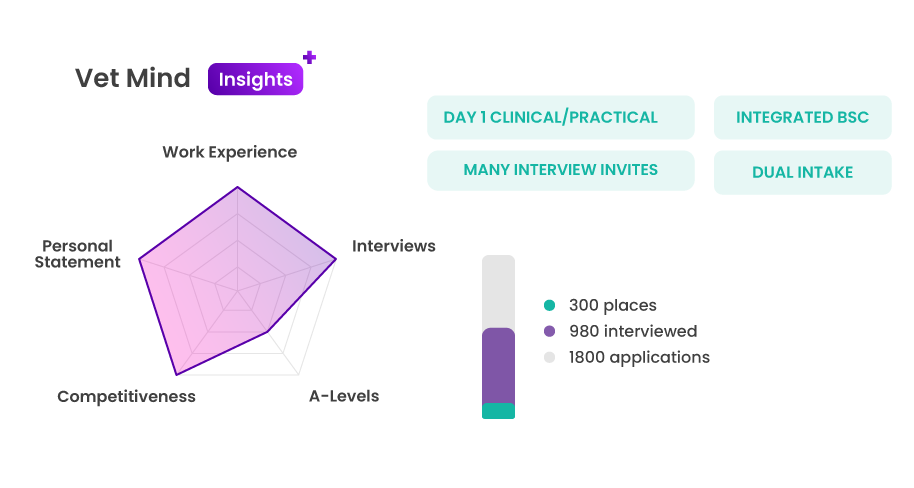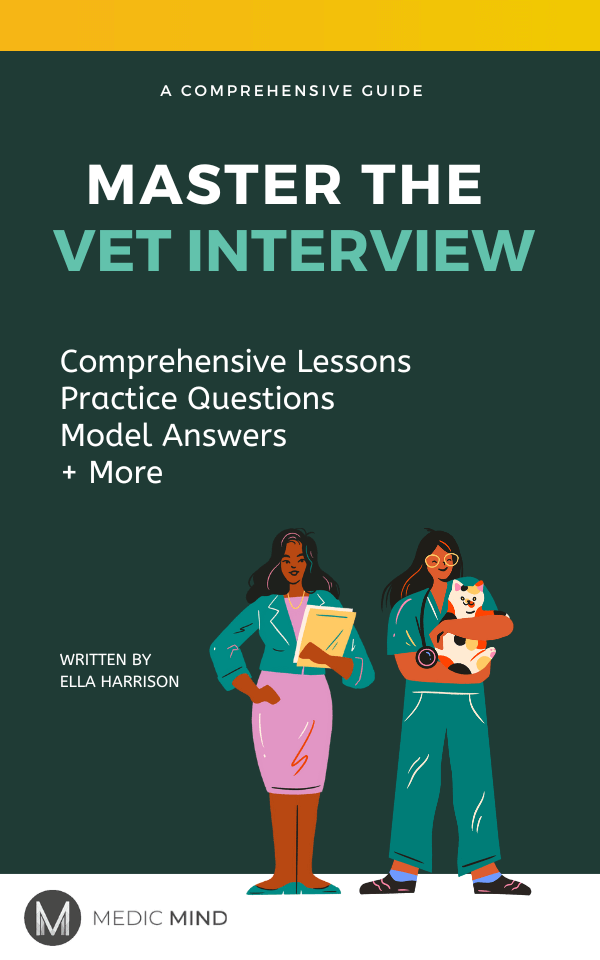Nottingham School of Veterinary Medicine and Science

Overview
Having set the example in the UK veterinary medicine scene of practical, hands on, learning, the university of Nottingham will offer you the most extreme of this approach. Based on its own ‘Sutton Bonington’ Campus in the outskirts of Nottingham with its own, nearby working dairy farm and a plethora of clinical facilities such as a working teaching hospital on site, Nottingham veterinary school take practical learning a step further by introducing you to clinical examples and settings from day one so if you are keen hands-on learner then Nottingham is the place to be. In addition, this campus is the location of the majority of Nottingham’s animal and
agricultural science courses making it a fantastic centre for research thus allowing you to immerse yourself in various scientific projects.
Key Points
- Day one clinical
- Relaxed on grades
- Two intakes
Insider’s Guide to Nottingham Veterinary School from Tetiana T, Nottingham Veterinary Student
What makes Nottingham unique to other veterinary schools?
Nottingham definitely has the most practical course out of all of the other universities. You start gaining clinical exposure from your very first weeks. I find this aspect extremely helpful. It is a brilliant way to engage with the information that you are learning in lectures, and gradually start to apply it to clinical situations. For example, when learning about the anatomy of the forelimb, we would consolidate our knowledge by following content up with dissections. Being able to see the muscles and bones and understand where they are in 3D space is so helpful for learning anatomy. By the time that I have finished my first year, I will know how to do so many things that other vet schools only start teaching students during their clinical third years. It is a massive advantage. You start learning dissection techniques, clinical procedures, and animal handling skills immediately. For instance, I’m only on my eighth week of teaching, but we are already being exposed to MRI scans – something that a lot of vets may struggle with in practic! So by the time that you finally reach your clinical years, you have a head-start above everybody else. You get so much practice at doing things like reading MRI scans, that you gradually start getting the hang of it. And by the time that you graduate, you are more proficient at it than somebody who has had only two years to practice it.

Course Structure at Nottingham Veterinary School
Year 1 at Nottingham Veterinary School
The main modules taught this year are the neuromuscular system and circulatory and respiratory systems, alongside animal health and welfare.
Year 2 at Nottingham Veterinary School
Year 2 has a similar structure to Year 1, which the modules taught being the endocrine and integument system, urogenital system, and gastrointestinal system.
Year 3 at Nottingham Veterinary School
The year begins with a short research project, followed by the beginning of clinical teaching.
Year 4 at Nottingham Veterinary School
A year of clinical teaching, which immediately leads onto the 5th year when clinical rotations begin.
Year 5 at Nottingham Veterinary School
An entire year of clinical rotations and elective weeks at the very end. There are no lectures during this academic year!
Teaching Style at Nottingham Veterinary School
What is the general teaching style at Nottingham? E.g. is it PBL/Traditional? etc.
Nottingham utilises a variety of teaching methods to ensure a holistic delivery of content. The main chunk of the content is delivered through a mixture of online and in-person lectures, all of which are recorded and always accessible to students. Other content is introduced through self-directed learning (SDL). This usually involves you being given a PowerPoint with guidance on what you need to learn. I have found the SDLs to be an absolutely brilliant way to develop my time management and research skills. As a graduate, you will regularly come across cases for which you may need to find more information. By developing these research skills early on, Nottingham vet students become very proficient at independently finishing their own resources out in practice. Furthermore, you get used to not having the answers given to you immediately, getting you used to uncertainty. This develops confidence in your own knowledge, ensuring that you can make decisions and trust yourself in the future.
Now onto one of my favourite parts of the course – the practicals. We have a minimum of one practical each week – it’s usually two or three! This is used to consolidate knowledge of anatomy, imaging techniques, as well as learn clinical skills. Small group teaching is used to consolidate and deepen our knowledge of what we learn throughout the week, as well as improve awareness of ethics and topical issues. This is a brilliant way to meet people and develop your ability to communicate effectively with each other. Finally, regular workshops and wrap-up sessions are opportunities to consolidate the content on an almost weekly basis. These tend to be interactive and Q&A sessions with a fun Kahoot to mix things up!
Does Nottingham offer dissection?
Yes, answered in other questions.
Does Nottingham offer a BSc? If so, how is the BSc year?
Nottingham offers an opportunity to intercalate in a second degree after the third year of teaching. This second degree is a teaching course that runs alongside the vet school. As a teaching student, you are given opportunities to help teaching staff during sessions such as practicals, giving you a direct experience of working with students. This is a brilliant degree to intercalate in for anybody who may be interested in working in teaching in the future. Vet students also say it is a great break away from the difficult workload of the main course!
What is the pre-clinical / clinical split like? Do you get early clinical exposure?
Answered in questions about what makes this university unique.
Social Life at Nottingham Veterinary School
What are the clubs and societies like?
Despite Sutton Bonington (SB) being a 30 minutes bus ride away from the main campus in Nottingham’s city centre, there is still plenty to do on campus! There are a variety of societies and sports clubs dedicated solely to students studying on SB. My favourite is climbing. It’s a brilliant way to both enjoy yourself and meet so many new people! Unfortunately, there aren’t quite as many sports clubs at SB as there are on the main campus. This can prove to be a bit tricky for people who want to participate in competitive sports that only run on the main campus. Some people decide to live in the accommodation there instead, despite it meaning that they have to travel to lectures every day. Otherwise, getting from SB to the main campus is very easy – you can even do some work on the bus!
What is the social life like?
As I’m not somebody who enjoys clubbing or partying, I wouldn’t be able to comment on what that aspect of the social life on SB looks like! What’s great, is that if you’re someone like me, there are still social events to get involved in that don’t involve drinking or loud music. The campus regularly hosts dining evenings, pub quizzes, movie nights, games evenings, and much more. There’s something to get involved in for everyone! The vet school also runs several veterinary societies. The one I’m most active in is the Surgical Society. And it’s awesome! I’ve only been to a few sessions so far, but I have learnt how to correctly use equipment, suturing techniques, and even got to practice my new skills on some pork bellies! It’s a brilliant society to get involved in if you’re interested in surgery like I am.
FAQs
The Nottingham School of Veterinary Medicine and Science (SVMS) is a leading institution in the field of veterinary education and research. It is part of the University of Nottingham, and is located on the Sutton Bonington Campus in Nottinghamshire, England.
The Nottingham SVMS offers a range of undergraduate and postgraduate programs, including Bachelor of Veterinary Medicine and Surgery (BVMS), Bachelor of Veterinary Science (BSc), Master of Science (MSc), and Doctor of Philosophy (PhD) degrees.
The admission process for the BVMS program at the Nottingham SVMS includes an application, interviews, and assessment of academic performance and work experience.
The Nottingham SVMS has research expertise in a wide range of areas, including infectious diseases, animal behaviour and welfare, veterinary epidemiology, and regenerative medicine.
Yes, the Nottingham SVMS has a Small Animal Teaching Hospital that offers veterinary services to the public, including consultations, diagnostic tests, surgeries, and treatments.
Graduates of the Nottingham SVMS have a range of career opportunities, including working in veterinary practice, research and development, academia, government agencies, and animal welfare organizations.
There are several things that are special about the Nottingham School of Veterinary Medicine and Science:
State-of-the-art facilities: The Nottingham SVMS has world-class facilities, including teaching and research laboratories, a veterinary pathology unit, a large animal unit, an equine unit, and a Small Animal Teaching Hospital. These facilities provide students with hands-on experience and allow researchers to conduct cutting-edge research.
Strong focus on research: The Nottingham SVMS has research expertise in a wide range of areas, including infectious diseases, animal behaviour and welfare, veterinary epidemiology, and regenerative medicine. The research conducted at the school is aimed at improving animal health and welfare, as well as advancing human health.
Emphasis on practical experience: The BVMS program at the Nottingham SVMS includes practical experience in veterinary medicine and surgery, which is integrated throughout the program. This provides students with real-world experience and prepares them for careers in veterinary medicine.
Small class sizes: The BVMS program at the Nottingham SVMS has small class sizes, which allows for a more personalized learning experience. Students receive individual attention from faculty members, which helps them to develop their skills and knowledge.
Commitment to animal welfare: The Nottingham SVMS is committed to animal welfare and works closely with animal welfare organizations to promote the health and well-being of animals. This commitment is reflected in the school’s research, teaching, and clinical activities.
Overall, the Nottingham School of Veterinary Medicine and Science is a leading institution in the field of veterinary education and research, with state-of-the-art facilities, a strong focus on research, an emphasis on practical experience, small class sizes, and a commitment to animal welfare.
About the university
| Key Information | |
| Website | https://www.nottingham.ac.uk/vet/ |
| [email protected] | |
| Phone number | +44 (0)115 951 6116 |
| Course Information | |
| Teaching style | Vocational/Integrated Hands-on clinical practice from day one Continuous animal management and handling practice, achieved through learning with an animal in front of you and by being tasked with the care of a variety of on-site animals. Problem-based learning. Teaching is also delivered through ‘body system-based modules’. This integrates the traditional medical subjects like physiology and anatomy. You will learn these modules twice, firstly as a science subject in the first two years and later on as a clinical subject in the fourth and fifth year. BVMedSci is integrated in the course meaning you don’t have to spend an extra year within your studies to graduate with this. |
| Course length | |
| BSC | |
| Courses offered | |
| Graduate entry | |
| Foundation or access | |
| University Life | |
| Local area | Sutton Bonington You along with other biological/agricultural science students will be based at the Sutton Bonington Campus located on the outskirts of Nottingham. This campus will consist of everything you need from its own sports centre to the nearby working dairy farm. |
| Social life | Since you are only a short bus journey away from Nottingham’s main campus you won’t miss out on any of the night-life events organised here. You can also expect a vibrant night-life in the actual city of Nottingham. Furthermore you will find a plethora of societies to join at each campus and whilst Sutton Bonington has its own, the main campus boasts one of the most impressive university sports centres to date. |
| Interview | |
| Interview style | Panel |
| Interview dates | |
| Interview topics | |
| Admissions Tests | |
| UCAT | N/A |
| BMAT | |
| GAMSAT | |
| Academic Requirements | |
| GCSE | |
| A-level | |
| Retake policy | |
| Scottish highers | |
| Scottish advanced | |
| IB | |
| Bachelor's Degree (Gradutes Only) | |
| Statistics | |
| Number of applicants per interview (Home) | |
| Number of applicants per interview (International) | |
| Number of applicants per place (Home) | |
| Number of applicants per place (International) |





Was this article helpful?
Still got a question? Leave a comment
Leave a comment